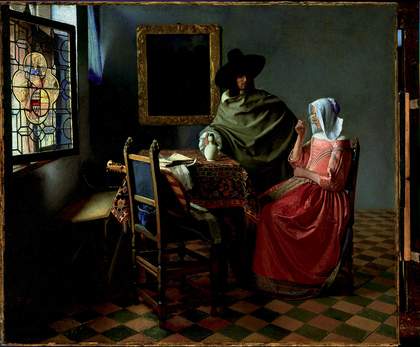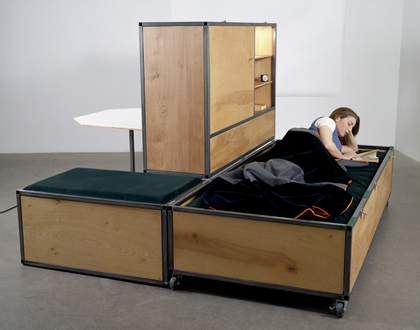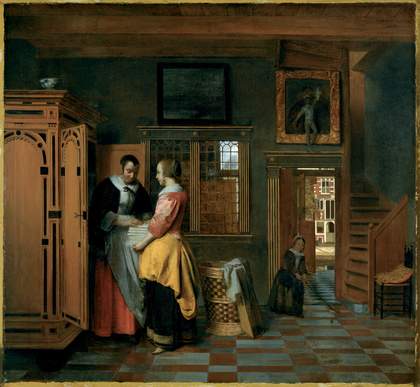Despite the early twentieth-century Modernists turning away from depicting domesticity and interiors, the subject has repeatedly been of interest to artists – from Matisse’s study in colour and composition to, more recently, Gregor Schneider’s obsessive and often claustrophobic transformation of his father’s house in Germany.
Since he was sixteen, the German artist Gregor Schneider has been transforming the interior of his father’s house into a series of claustrophobic rooms, chambers and dark basements, some of which have fake partitions, while others are furnished with strange tableaux of found objects. He reduces passages to tunnels that the visitor can only crawl through with some considerable difficulty. He has spent more than twenty years with Haus ur, altering and rebuilding it, before dismantling sections and reconstructing them at other public locations. Schneider’s approach to the domestic interior is obsessive, focusing on the physical experience of these places, while other contemporary artists have explored less physically intensive practices. Andrea Zittel’s miniscule Living Units, conceived as mobile interiors, function as a kind of alternative domestic idealism, while Eija-Liisa Ahtila’s video installation The House 2002 is a fictional narrative based on actual interviews with women who have developed psychoses. The opening voiceover in The House is that of a woman talking about her domestic routine, before she and everything around her changes and internal and external images become indistinguishable.
Recently, the subject of the interior, in particular the private interior, has again become popular. The early twentieth-century Modernists turned away from depicting domesticity in their work. They saw the interior as a reflection of the nineteenth century’s “addiction to the home”, as Walter Benjamin described it, when people wanted only to shut themselves away – to creep into the shell of their own domesticity. As a result, the home barely features in early twentieth-century art. And where it does appear, it is not a cosy escape into an inner sanctum. Instead, it is one ruled by external forces, and frequently an image of a troubled relationship with the world and the self, which sometimes also wishes to draw the viewer into the picture. In his book Aesthetics, Hegel identified the “picture of a room” as a precise expression of the modern state of mind, for – much more so than the landscape – it shows humans engaged in activities that are, in turn, reflected in their surroundings.
The interior became a genre in its own right with the rise of the bourgeoisie. The earliest paintings were from seventeenth-century Holland and developed initially from religious imagery, in particular from subjects that might have references to interiors, such as the Annunciation, St Jerome in his study, or the birth of a saint – a place where the Word became flesh; the presence of the divine in earthly existence. These religious roots were obscured by narratives that appeared entirely worldly. Making music, reading, practising handicrafts and preparing food were among the favourite themes of the day, allowing the artist to portray both prosperity and domestic virtues. Yet the images of well-ordered domesticity were often full of visual tensions. Artists played with the idea of thresholds – doors and windows – that defined the interior, yet linked it to the outside world, often depicted through how the characters moved and where they looked. Pieter de Hooch’s painting Interior with Women Beside a Linen Chest 1663 is a good example. The interior is not only an enclosed, but also a layered, interlocking space. Vistas, doorways and pictures within the picture separate the private world from the outside one. The two women on the left are concentrating on their job of packing away a stack of linen. Meanwhile, on the right-hand side, the interior is opened up by the figure of the small girl playing with a stick and ball in front of the doorway. She is looking back at us, but we can also see beyond her; our line of vision guided through the open door, and out into the street.

Jan Vermeer
The Glass of Wine 1661–2
Oil on canvas
65 x 77 cm
Courtesy Gemäldegalerie, Berlin
Frequently, male figures intrude into a domestic scene. In Vermeer’s painting The Glass of Wine 1661–2, set in a daylight bourgeois room,a man is encouraging a young woman to indulge in a little wine. The lute laid to one side and the scattered sheet music add an erotic undertone, offset by the couple’s heavy clothing. Their bodies are hidden behind fabrics and folds – his under a cloak and hat that he still has not taken off, and hers under the stiff armour of her dress that emphasises her lower body and the scarf that covers her head. There is no physical contact, just a look. The man contemplates the woman. She can’t see him, his face obscured by both her headdress and the glass. There are further symbols of restraint. The coat of arms in the open window is emblazoned with an emblem of temperance, with a compass and a bridle – the sign of moderation. The scene is too understated for it to be interpreted as a straightforward seduction. In the same way that there is not even a glimpse of the outside world through the open window, the state of mind of the two figures remains hidden, despite their suggested desire of each other. And here, there is a place for the viewer in the shape of the chair in the foreground, a device that both draws us into the scene and forms a barrier. The meaning of the picture as a whole – like the interior portrayed within it - is both accessible and blocked.
In the Modernist era the interior is no longer a world theatre. It becomes a telling measure of a person’s state of mind – a self-constructed environment where the individual is literally in a world of their own, and one that they have made. Henri Matisse had a passionate interest in the interior, usually animated by female figures – reading, dreaming, or sitting as models in a studio that has been assimilated into the artist’s home. At first sight Matisse’s paintings appear to be harmonious, even backwards looking representations of a world that knows no conflict. Yet there are also jarring moments. In Harmony in Red 1908 the three-dimensional space has become a plane bathed in a glowing red and embellished all over with decorative features that transpose the woman’s curvaceous outline into her surroundings. In the window, which looks like a painting hung on the wall, we see a landscape. The black and white of the trees and the sweeping lines of the branches echo the figure inside, while the fruits from the trees are now arranged in the room, like a eucharistic promise. The interior and the exterior both conform to the same order – artistic rather than divine – where nature is cultivated and the interior is preserved as an entirely natural space. Only now the viewer is excluded from this cosmos. Even though there is an empty chair to sit on, it would mean looking out of the picture. The fantasy of a comfortable, self-contained world is seen to be exactly that, because it remains within the frame of a composition that obeys only its own laws.

Andrea Zittel
A to Z 1994 Living Unit Customised for Eileen and Peter Norton 1994
Steel, wood, paint, mattress, glass, mirror, lighting fixture, upholstery
93.3 x 213.4 x 96.5 cm
Courtesy Andrea Rosen Gallery, NY © Andrea Zittel
Matisse’s later work was all about internalising the world, and figures reading embodied the notion of a person lost in an inner universe of their own, which he liked to incorporate into his painting. This connection between painting and reading is exemplified in The Painting Lesson 1918–19, an interior where a mirror reflects the outside - an image of the sea that neither the reading girl nor the painter is involved with. As the girl’s lowered eyelids and the painter at his easel suggest, their attention is interior. His expression of such an inner world is revealed in the impenetrable black paint of the picture’s backdrop. Matisse’s Odalisques take this tendency to externalise internal issues a stage further. No outside influences penetrate these rooms; the fantasies in the theatrical trappings of Orientalist settings and costumes are blocked by patterns and colours.
Modern interiors show that a person’s immediate surroundings don’t necessarily constitute a secluded refuge where the individual, far from the public gaze, can be alone and has no need to enact any particular role. The interior is still a stage that reveals how people make a place for themselves in the world and never lets the players forget that there is always an audience. It is hardly surprising that Postmodernism has relished this theatricality. The photographs that Nan Goldin has been taking of drag and glamour queens on their own territory since the 1970s tell of a very particular urge to create a place of one’s own. These images, spatial and emotional close-ups, are not about revelation; they do not seek to unmask the real person behind the glamour. On the contrary, they confirm that identity is formed only through role-playing, by figures that are at one with their made-up faces. Goldin demonstrates how her protagonists position themselves in the world by the effort they make with their own physical appearance. By contrast, in Haus ur Gregor Schneider concentrates on the interior of his home, and it becomes clear that he and his surroundings mutually configure each other. The optical barricades with which Vermeer and Matisse prevented access to their interiors are now a physical reality: one’s perception of this world no longer occurs through a detached sense of sight, but involves one’s whole body, as becomes painfully obvious to those who explore Schneider’s installation. There is nothing homely about this uncanny house that physically confronts us with the effort needed to make one’s own world and to access its inner realms. The Coffee Room has an invisible rotating mechanism built into it. Anyone attempting to leave comes up against a brick wall. The visitor is now literally in the picture, is caught, is held captive in what he or she has made of the interior. This work unmistakably reminds us that we will never be king of our own castle.

